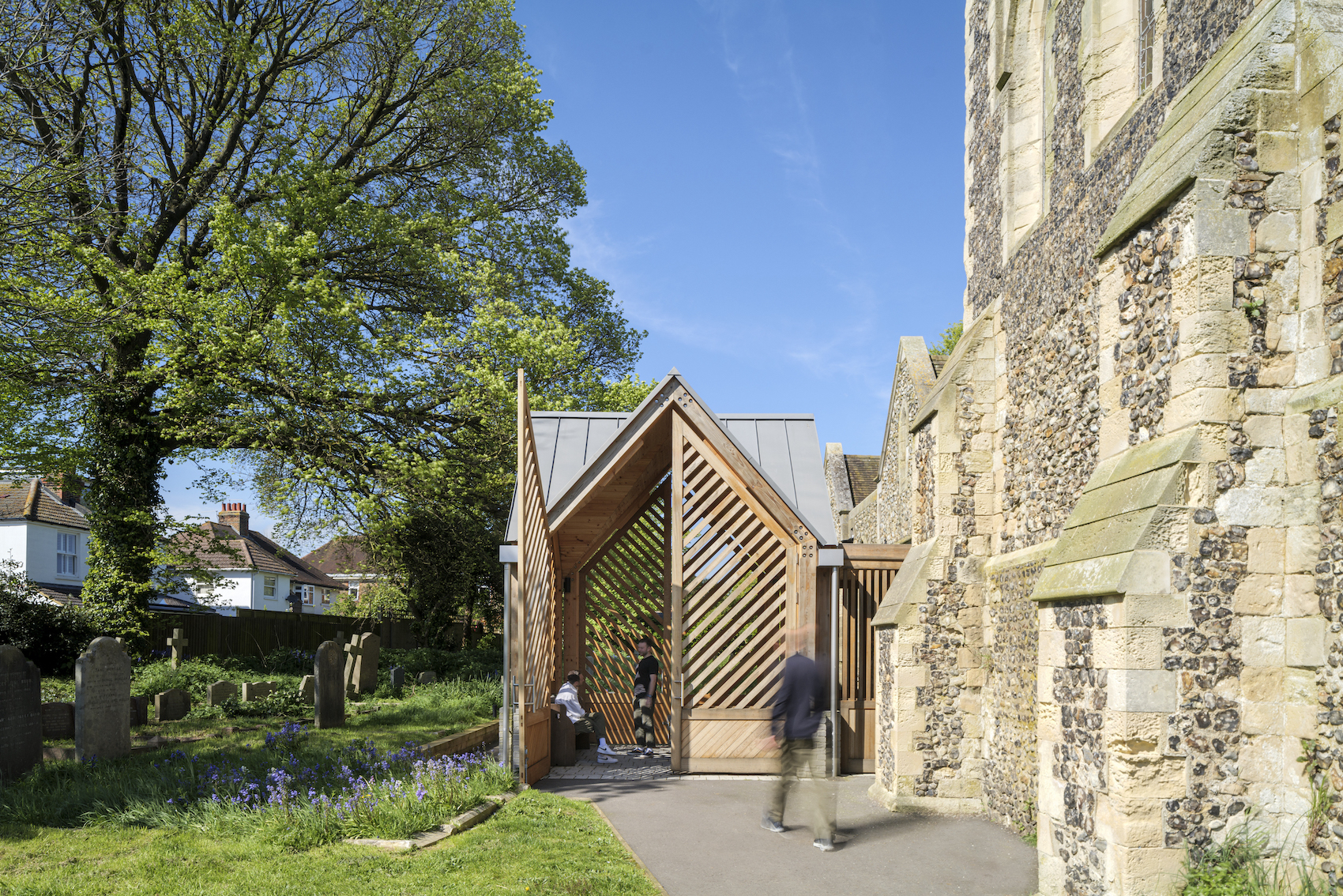John Puttick Associates’ sympathetic refurbishment of St Leonard’s Church in Hove, East Sussex, delivers an adaptable community resource marked by a striking timber porch.
Photos
Gareth Gardner
Won in competition, John Puttick Associates’ sensitive refurbishment of St Leonard’s Church in Hove, East Sussex, has breathed new life into the Grade-II listed building and delivered an adaptable community resource to the local area. Located on New Church Road, the Victorian structure incorporates a textured facade of knapped flint across its double-nave form. Central to the project is a new 4.5 metre-high glulam entrance porch topped by a standing seam zinc roof.
“A key aspect of the brief was to improve the flexibility of the church building, allowing multiple worship and/or community activities to take place concurrently,” explains John Puttick, Architect & Director at John Puttick Associates. “At the early stages of the design process, we undertook a series of layout studies considering how the plan could best be arranged to facilitate this, which were discussed in depth with the church and congregation.
Prior to the refurbishment, the church was typically entered by the southern porch, which is centrally located in the southern nave. This meant that visitors entered the centre of the space – disrupting any activities – and had to walk through the middle of it to join any events in the northern nave. The western entrance of the church was both physically modest, and so not easy to find, and physically very hard to open.
The new porch highlights the western entrance, making it the natural point of arrival and showing that the church is open to the community. Visitors now arrive at the rear of the northern nave, from where they can move to other parts of the church without disrupting activities. New glass screens separate the northern and southern naves to allow events to take place concurrently, and a door in these – close to the western entrance – allows discreet movement between the two. New facilities near the entrance (buggy parking space and accessible WC) can also be easily reached. The western end is also the traditional point of arrival in a church, and so the refurbishment returns the building to what is likely to have been its original orientation.”
“Throughout the project, material choices were made with a view to how they respond to the historic setting, environmental considerations, and long-term robustness in a busy public building,” continues Puttick. “St Leonard’s church has an original timber lychgate at the entrance to its grounds and the existing southern porch which is also a timber structure. The new porch was conceived as a contemporary addition to this family of satellite structures, and so timber was a natural choice, as well as benefiting environmentally from carbon sequestration. We worked closely with structural engineer Momentum to develop the glulam solution that forms the generous and welcoming dimensions of the entrance.
Internally, as the church was to be reconfigured, we were looking for opportunities to reuse elements of the existing joinery. Again, this had a dual purpose – to retain the character of the original building and make best-use of existing materials to reduce the environmental footprint of the project. The choir stalls had attractive timber enclosures with deep reveals that produce an enjoyable tectonic effect. These were carefully removed by the joiners and re-installed as the frontage to the new community café servery.
In the original church interior, a herringbone pattern can be seen in several locations – most notably in the encaustic tiles that form the floor of the sanctuary of the southern nave (the oldest part of the church). To relate new-build installations to the historic building, we interpreted this into a contemporary herringbone pattern in the detailing. Examples of this include the new WC pod in the southern nave where a herringbone arrangement of timber slats and acoustic infills clad the exterior; joinery items where timber panels have been installed with a herringbone joint pattern; and the open herringbone slats of the new porch doors.”
Elsewhere, the building’s environmental performance has been boosted with an air source heat pump and an underfloor heating system installed on top of the original parquet flooring. Outside, landscaping improvements include the renewal of pathways, a new outdoor seating space, and exterior path lights for better accessibility and visibility.
“Since reopening, St Leonard’s is already being actively used by a wide range of groups,” concludes Puttick. “These range from contemporary and traditional worship, conferences, community events in the new café, and children’s activities in the large northern nave where all chairs as removed to allow active play. The changes made to the arrangement of the church provide a framework for the building to be used by multiple groups concurrently, with spaces ranging in scale from the large northern nave, through the more intimate southern nave, to the smaller single storey creche area. New lighting and AV installed also offers enhanced possibilities for performances that can take place in the building.”
Additional Images
Credits
Architect
John Puttick Associates
Conservation architect
Cerowski Architects
Structural engineer
Momentum
Services engineer
MCA Consulting Engineers
Quantity surveyor
Riverstone Projects
Contractor
DBR
Client
St Leonard’s Church
Source: Architecture Today







